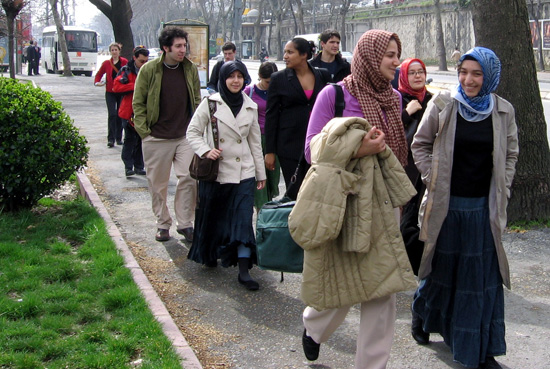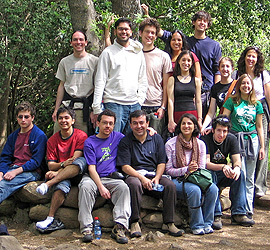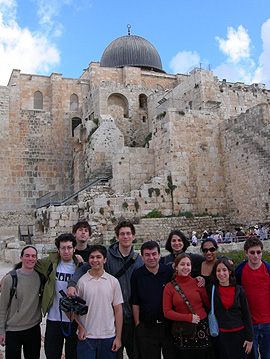Breaking Down the Barriers: Trip to Middle East Provides Examples of Peaceful Co-Existence
 |
 Pictured at top, Wesleyan students and staff walk down a street in Istanbul on their way to the mosque during a trip to Turkey and Israel March 12-23. Pictured at top, Wesleyan students and staff walk down a street in Istanbul on their way to the mosque during a trip to Turkey and Israel March 12-23.
Pictured at right, the group takes a break in the Teldan Nature Preserve in Golan Heights, Israel with their tour guide. The Wesleyan students are Ben Sachs-Hamilton, Avi Smith, Phil Zegelbone, Jamal Ahmed, Mike Figura, Kulsoom Hasan, Maggie Mitchell, Tussy Alam, Rachel Berkowitz, Aaron Tabek, Jessica Eber and Joel Bhuiyan. Wesleyan Rabbi David Leipziger Teva and Abdullah Antepli, pictured in center in purple and black shirts, coordinated the overseas trip. |
| Posted 04/17/06 |
| Wesleyan Jewish Chaplain Rabbi David Leipziger Teva, wanted to prove to his students that Jews and Muslims can peacefully coexist with one another. But Leipziger Teva, who also goes by Rabbi David, admits that for students to understand this complex co-existence, they must couple classroom knowledge with real life, personal experiences. So Leipziger Teva and former Wesleyan Muslim Chaplain Abdullah Antepli chose five Wesleyan Muslim students and six Jewish students, out of 23 who applied, and set out for an 11-day spring break excursion of Istanbul, Turkey and Jerusalem, Israel. The trip was very intense, admits Leipziger Teva, who says he was most moved after seeing Palestinian and Israeli Christian, Muslim and Jewish children learning together in one classroom at the K-6 Hand-in-Hand School in Jerusalem. The group also visited Kibbutz Metzer, an Israeli socialist commune, where member Dov Avital shared his story about living peacefully, just yards away, from a Palestinian-Arab village. In November of 2002, suicide bomber from a radical Palestinian terrorist group broke into this Israeli Kibbutz and killed five people. Leipziger Teva says that despite the terrorist attack the two communities remain committed to dialogue and friendship.
Jamal Ahmed, a Pakistani freshman from New York City, was also moved by Avitals story. On the trip, we learned that there was a sense of hope, a hope for peace, says Ahmed. Despite terrible hardships, there are still great strives towards peace and beautiful co-existence. I learned more about the Jewish culture, religion, and Israeli society than I thought possible in such a short time.” The group also met with journalists, lobbyists, human rights activists and political leaders, including Vatican Representative of Istanbul, George Marovitch and Chief Rabbinate and Rabbi of Turkey Isaac Halevo. They also visited popular landmarks including the Temple Mount, the Western Wall as well as other mosques, synagogues and visited with Jewish and Muslim religious leaders and families.Rabbi David says that during their trip, he witnessed a progressive transformation among the students. I saw a deepening of their individual religious spiritual identities, he says. They were all challenged and I was constantly motivated by the dialogue that was happening. Rachel Berkowitz a freshman from Trumansburg, NY, says the trip helped her gain a strong desire to learn more about Islam, Judaism, interfaith dialogue and about the Israeli-Palestinian conflict. I think the difference I have made has been internal, rather than external, says Berkowitz. I have learned and changed so much. I feel I now have a broader perspective. Leipziger Teva hopes that one day this Spring break trip will spark these students into making strides towards peace in the Middle East. Someone from this trip might one day become a senator, a Fulbright Scholar, or eventually may help draft future peace plans for Israel, says Leipziger Teva, who feels that both the Israeli and Palestinian sides need to demonstrate compromise before real peace is established. Next month Leipziger Teva, who is hoping to raise more funds in order to repeat the trip next year, will start showcasing a DVD documentary of the trip to mosques, churches, synagogues, and to high schools. He also plans on introducing the documentary at the Muslim Student Association Annual Conference and Hillel, the conference of Jewish College Communities later this year. No other school has ever taken Jews and Muslims together in one group to the Middle East, says Leipziger Teva. Wesleyan is unique and we hope we can help jumpstart dialogue and peace among all the children of Abraham Jews, Muslims and Christians. |
| By Laura Perillo, associate director of Media Relations |


 Dov told the story with tears in his eyes and we were all moved by it, says Leipziger Teva. This is just one hopeful example, despite the violence of how Jews and Muslims are trying to co-exist with each other in peace and we wanted the students to see this.
Dov told the story with tears in his eyes and we were all moved by it, says Leipziger Teva. This is just one hopeful example, despite the violence of how Jews and Muslims are trying to co-exist with each other in peace and we wanted the students to see this.